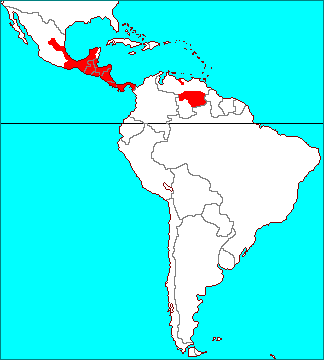
México, Guatemala, Belize, Honduras, Nicaragua, El Salvador, Costa Rica, Panama, Venezuela
México (San Luis Potosí, Veracruz, Morelos, Oaxaca, Tabasco, Chiapas, Campeche, Yucatán)
Guatemala, Belize, Honduras, Nicaragua, El Salvador, Costa Rica, Panama
Venezuela (Aragua, Bolivar)
600 - 1,200 m elevation
Epiphytic on oak and pine-oak trees and shrubs, Saxicolous on rocky slopes and cliffs
Tillandsia brachycaulos
Tillandsia (Tillandsia) brachycaulos Schlechtendal (1845)
- [ Etymology ] brachy + caulos in Latin (short + stem)
- Leaves turn bright red during the flowering period.
- Tillandsia velutina produces a very short inflorescence, whereas flowers of Tillandsia brachycaulos grow directly from the growing point.
- Tillandsia abdita was defined by trichomes on the surface of floral bracts. Trichomes are not on the surface of floral bracts of Tillandsia brachycaulos and Tillandsia velutina. T. abdita became a synonym of T. brachycaulos.
- [ Width ] 25 cm
- [ Height ] 10 cm
- [ Petal ] Purple
- [ Bract ] Red
- [ Flower ] June
- [ Flower ] for 6 days
- [ Cultivar ]
- Selecta (The whole foliage turns bright red.)
Classification
- [ Genus ] Tillandsia
- [ Subgenus ] Tillandsia
- [ Species ] brachycaulos
- [ Variety ]
- brachycaulos
- multiflora => Tillandsia x Zacapa
- [ Synonyms ]
- Tillandsia (Tillandsia) abdita L. B. Smith (1961)
- Tillandsia (Tillandsia) bradeana Mez and Tonduz (1916)
- Tillandsia flammea Mez (1935)
Cultivation
Informations summarized here are based on our experiences, and TrekGEO does not guarantee the results by cultivating in the same or similar conditions described here. Even a species of Tillandsia differs substantially between individuals, and is very sensitive in changes of environments. Applicatons of any idea inspired by this site should be at your own risks.
3rd Plant
- Cultivation condition
- Partial shade, Dipping, Shelving, AC / Heater
- May 2025 An inflorescence began to grow.
- Jun 2024 Roots began to grow.
- May 2023 Many roots began to grow.
- Up to this point
- Partial shade, Long soaking, Shelving, AC / Heater
- Nov 2021 It keeps growing.
- Up to this point
- Partial shade, Long soaking, Shelving, Summer AC
- Apr 2020 It keeps growing.
- Up to this point
- Partial shade, Long soaking, Shelving, Indoors
- Apr 2018 It keeps growing.
- Jul 2017 Roots began to grow.
2nd Plant
- Cultivation condition
- Partial sun, Dipping, Shelving, AC / Heater
- Jul 2024 It keeps growing.
- Jul 2023 Roots began to grow.
- Apr 2022 Roots began to grow.
- Up to this point
- Partial sun, Long soaking, Shelving, AC / Heater
- Nov 2021 It keeps growing.
- Jul 2020 Roots began to grow.
- Up to this point
- Partial shade, Long soaking, Shelving, Summer AC
- Apr 2020 It keeps growing.
- Aug 2018 2 offsets began to grow at base of the inflorescence.
- Jun 2018 It bloomed.
- May 2018 An inflorescence began to grow.
- Up to this point
- Partial shade, Long soaking, Shelving, Indoors
- Apr 2018 It keeps growing.
- Jun 2017 Roots began to grow.
- Sep 2016 A pup in a good condition.
1st Plant
- Cultivation condition
- Partial shade, Long soaking, Shelving, Indoors
- Oct 2006 Moved to another site. Cultivation condition is almost same as the previous site.
- Jun 2006 The two roots began to grow.
- Jul 2005 The original foliage has died.
- Dec 2004 The second offset began to grow.
- Sep 2004 An offset began to grow.
- Aug 2004 Its condition is very bad.
- Aug 2004 The inflorescence died without blooming because of scale insects (Coccidea) or hot and humid weather.
- Aug 2004 The inflorescence has died. The temperature rises above 30 degree C for 40 days, and the highest temperature was over 39 degree C.
- Jun 2004 An inflorescence with ruby red color began to grow.
- Dec 2003 The foliage become healthy. Tips of leaves turned red.
- Sep 2003 Tips of leaves are dying.